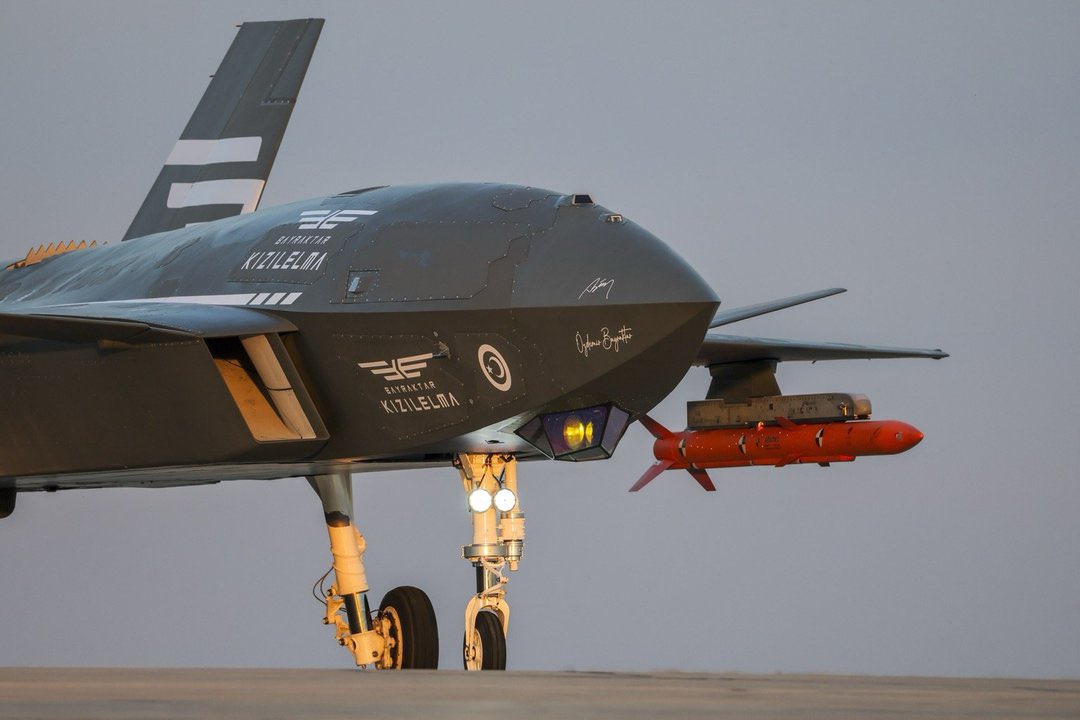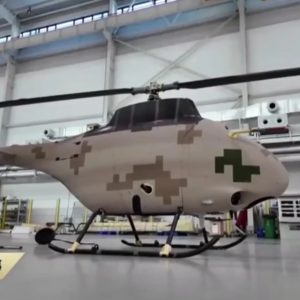Baykar has released new footage of its jet-powered Bayraktar Kızılelma unmanned combat aircraft carrying two Gökdoğan beyond-visual-range air-to-air missiles. The short clip, taken during the PT-5 phase of the test campaign, shows the UCAV taxiing. It then takes off with the missiles mounted on its inner wing pylons. The Kizilelma Gokdogan air-to-air missile test marks a deliberate step toward giving Türkiye’s flagship UCAV a true air-combat role.

From runway footage to air combat ambition
In its announcement, Baykar described the event as a “GÖKDOĞAN Munition Linked Flight Test & EOTS–MURAD AESA Radar Performance Test.” The wording matters. It indicates that engineers were validating safe carriage of the missiles. They were also checking that the electro-optical targeting system and active electronically scanned array radar can support future engagement profiles.
During the PT-5 phase, Kızılelma flew with two Gökdoğan rounds installed on its inner stations, while outer pylons remained empty. Baykar has not yet disclosed a firing schedule from the UCAV. The company has already supported live tests of Gökdoğan from F-16 fighters. Those firings show that the missile itself is moving toward operational service, even as the Kizilelma Gokdogan air-to-air missile test campaign expands to unmanned platforms.
The latest flight also builds on recent work to integrate the indigenous MURAD AESA radar and the TOYGUN electro-optical targeting system on Kızılelma. This early Kizilelma Gokdogan air-to-air missile test therefore doubles as a shakedown for the new sensor suite. Together, these sensors give the aircraft the ability to detect, track and classify both air and surface targets while maintaining a low observable profile. This combination is essential if the UCAV is to manage long-range missile shots without constant guidance from a manned fighter.
Technical insight: Pairing a jet-powered UCAV with an indigenous AESA radar, advanced EOTS and a domestic BVRAAM does more than add a new weapon. It turns Kızılelma into a networked air-combat node that can share, receive and act on targeting data across the battlespace.
A loyal wingman that can shoot back
Baykar conceived Kızılelma as a jet-powered unmanned combat aircraft for deep-strike missions in high-risk airspace. Baykar designed the platform to operate alongside fifth- and future sixth-generation fighters as a “loyal wingman,” absorbing risk that would otherwise fall on piloted aircraft. The airframe offers a maximum take-off weight of around six tons, a payload capacity of roughly 1.5 tons and endurance measured in several hours, giving planners real flexibility over contested territory.
Until now, most public discussion of Kızılelma has focused on strike roles, including stand-off attacks against high-value targets and suppression of enemy air defences. The Gökdoğan carriage test broadens that picture. It suggests that Turkish planners also see a future in which unmanned assets help secure air superiority, not only deliver precision weapons.
This shift matters operationally. A UCAV that can carry beyond-visual-range air-to-air missiles can patrol alongside manned fighters, contribute tracks to the common air picture and, when authorised, engage threats without risking a pilot. In high-intensity scenarios, formations of such aircraft could extend the reach of manned fighters or hold hostile assets at risk while crewed platforms focus on command and control.
Gökdoğan and Türkiye’s BVRAAM ecosystem
TÜBİTAK SAGE developed Gökdoğan as Türkiye’s first domestically produced beyond-visual-range air-to-air missile under the Göktüğ programme. The weapon uses an active radar seeker, a solid-fuel rocket motor and modern mid-course guidance. Open sources place its range beyond 65 km, which puts it in the same performance class as many Western BVRAAMs while keeping it fully under national control.
The missile also supports lock-on-after-launch and data-link updates. In practice, this means that a launching aircraft, crewed or uncrewed, can fire at a target that lies beyond its own radar horizon by using cues from other sensors in the network. For a platform like Kızılelma, which is being equipped with the MURAD AESA radar and advanced electro-optical systems, these features are central to effective beyond-visual-range engagements.
Gökdoğan does not stand alone. It sits alongside the shorter-range Bozdoğan within-visual-range missile and the upcoming ramjet-powered Gökhan in a growing domestic missile family. Together, these systems form a layered air-to-air portfolio that can arm F-16s, the future KAAN fighter and, increasingly, unmanned combat aircraft such as Kızılelma. Integrating the family across manned and unmanned platforms is a logical next step in Türkiye’s airpower modernisation drive.
From demonstrator to force element
Baykar presents Kızılelma as a fighter-class UCAV rather than a traditional medium-altitude, long-endurance drone. The aircraft’s jet propulsion, internal volume and payload capacity allow it to carry air-to-surface munitions, air-to-air missiles and advanced sensors at combat speeds. Importantly, the design also aims for operations from short runways and, in time, from suitable naval platforms, which could include future carriers or amphibious assault ships.
As Kızılelma matures, the concept of operations that surrounds it is becoming clearer. In one scenario, several Kızılelma aircraft fly in formation with a manned fighter, sharing sensor data and extending the formation’s reach. In another, a mixed package of manned and unmanned aircraft pushes into contested airspace, with Kızılelma absorbing the highest-risk tasks and Gökdoğan providing a credible deterrent against enemy fighters.
These ideas echo broader trends in allied air forces, where collaborative combat aircraft and remote carriers feature in next-generation airpower plans. Türkiye’s approach, however, leans heavily on a domestic industrial base that now includes indigenous radar, electro-optics and air-to-air missiles. That ecosystem reduces exposure to export controls and allows tighter tailoring of capabilities to national doctrine.
Strategic and industrial implications
The Kizilelma Gokdogan air-to-air missile test also carries strategic weight beyond the technical milestones. Each step toward a fully armed, networked unmanned fighter helps Türkiye close gaps in its air combat inventory without relying solely on imported platforms or munitions. It feeds directly into national goals of greater autonomy in critical defence technologies.
For the domestic industry, the test validates years of investment in enablers such as AESA radar development, secure data links and advanced guidance algorithms. Companies like Baykar, ASELSAN and TÜBİTAK SAGE are not just delivering stand-alone products. They are co-developing a tightly integrated suite in which sensors, weapons and airframes are designed from the outset to work together.
Clusters such as SAHA Istanbul, which brings together major primes, SMEs, universities and research institutes, play a quiet but important role in this picture. By aligning R&D agendas, export strategies and supply-chain development, they help ensure that breakthroughs in one programme, such as Kızılelma and Gökdoğan, spill over into wider industrial capabilities.
What comes next for Kızılelma
Looking ahead, the most obvious next milestone will be live Gökdoğan launches from Kızılelma itself. Successful firings would confirm that the UCAV can manage the full engagement chain, from detection and tracking through launch and post-launch support. Further trials are also likely to explore multi-ship operations, formation flight with manned fighters and complex scenarios that stress data links and autonomy.
Export interest will be another important indicator. Many air forces are exploring loyal wingman concepts but face budget constraints or technology-transfer limits. A combat-proven Kızılelma, able to carry indigenous BVRAAMs like Gökdoğan, would offer a distinctive proposal: a fighter-class UCAV that can defend itself and others while remaining outside the most restrictive export regimes.
For now, the latest Kizilelma Gokdogan air-to-air missile test is a visible waypoint on that road. It shows that Türkiye is not only fielding more capable drones, but also rethinking how unmanned systems contribute to air superiority, deterrence and coalition operations. As the test programme continues, Kızılelma looks set to become a core asset in the country’s next-generation airpower mix.
Further Reading
- MKE TOLGA: Türkiye’s new short-range air defence system – Defence Agenda internal analysis on domestic air defence developments.
- Bayraktar KIZILELMA official page – Baykar’s own overview of the unmanned fighter’s design and mission profile.
- GÖKDOĞAN BVRAAM technical overview – TÜBİTAK SAGE’s official description of the missile’s capabilities.
- KIZILELMA unmanned fighter flies with GÖKDOĞAN BVRAAM – Recent reporting on the latest linked flight tests.












